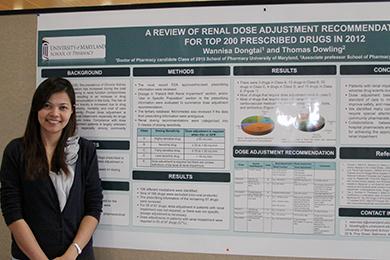Students and Trainees Showcase Their Work at SOP’s Annual Research Day
Forum offers opportunity to share current research and network with potential collaborators.

By Malissa Carroll
April 26, 2013
More than 70 student pharmacists, pharmacy residents, graduate students, and post-doctoral fellows participated in the University of Maryland School of Pharmacy’s annual Research Day on April 12, which highlighted the breadth and depth of research among the School’s students and trainees.
“Research Day gives students, postdocs, residents, and faculty a chance to share their research studies and learn about research going on in other departments,” says Peter Swaan, PhD, associate dean for research and graduate studies. “We hope that this venue will stimulate new collaborations across the School and within its variety of disciplines.”
One of the students who participated in the day’s activities was Keely Pierzchalski, a graduate student in the Department of Pharmaceutical Sciences (PSC). Pierzchalski presented her work highlighting the impact of cellular retinol-binding protein-1 (CRBP1), the carrier protein involved in the delivery of retinol to metabolizing enzymes to produce retinoic acid, on endometriosis.
“One of the problems with endometriosis treatment is that it is highly invasive. The gold standard is to perform surgery to remove the lesions in the endometrium,” says Pierzchalski. “Approximately 30-40 percent of women with endometriosis become infertile, and use in vitro fertilization (IVF) to become pregnant. However, after surgery, these women are often prescribed pain medication and hormone replacement therapy to treat their chronic pain, which can impede their odds of becoming pregnant through IVF.”
Pierzchalski, who works in the laboratory of Maureen Kane, PhD, assistant professor in PSC and assistant director of the School’s Mass Spectrometry facility, says that she hopes her work will lead to the identification of CRBP1 as a biomarker to indicate non-invasive treatment for endometriosis.
“Our studies have shown that endometriosis is associated with a loss of retinoic acid and a loss of CRBP1,” says Pierzchalski. “Following an initial biopsy, the tissue could be tested to determine if it is deficient in CRBP1. We could associate that deficiency with reductions in the levels of retinoic acid present in the tissue as well. This would allow providers to treat those patients to help restore retinoic acid levels in the tissue, which could potentially allow patients to avoid surgery.”
Allison Lardieri, PharmD, a School of Pharmacy resident in pediatrics, showcased her study analyzing the effects of clonidine on withdrawal from long-term dexmedetomidine, a new sedation medication, in 16 patients from the University of Maryland Medical Center’s pediatric intensive care unit.
“Currently, there is not a lot of literature that describes sedation in pediatric patients,” says Lardieri. “I think this study has provided us with a lot of interesting information about the use of this particular agent in the pediatric population and will help advance our knowledge about appropriate dosing and management of withdrawal symptoms our patients might experience.”
Tackling the hot topic of “personalized medicine” and its applications in the health care industry, Stephanie Zhang, a third-year student pharmacist, presented a review of web-based direct-to-consumer resources for pharmacogenomics testing.
“There are a number of direct-to-consumer companies that offer DNA testing to individuals without the need for a physician’s authorization,” says Zhang. “Consumers can order these test kits online, have them delivered directly to their homes, complete the test, and submit their DNA samples to the company for review.”
Companies perform hundreds of tests on the DNA sample submitted and send consumers a booklet of results to review. According to Zhang, there are a number of issues associated with this process.
“There is currently not enough clinical evidence or data to implement the results of these tests into practice,” says Zhang. “For example, one of the companies I reviewed provided individuals with results about their warfarin sensitivity, but what do those results tell us? Should we increase that person’s warfarin dose? Decrease it? Do nothing? This is one medication for which we currently do not have a fully established dosing algorithm.”



